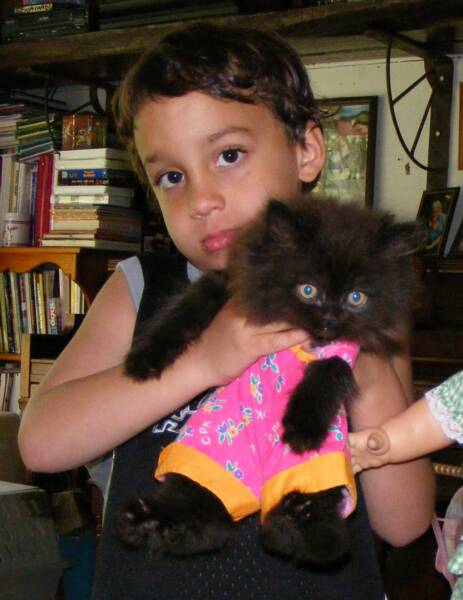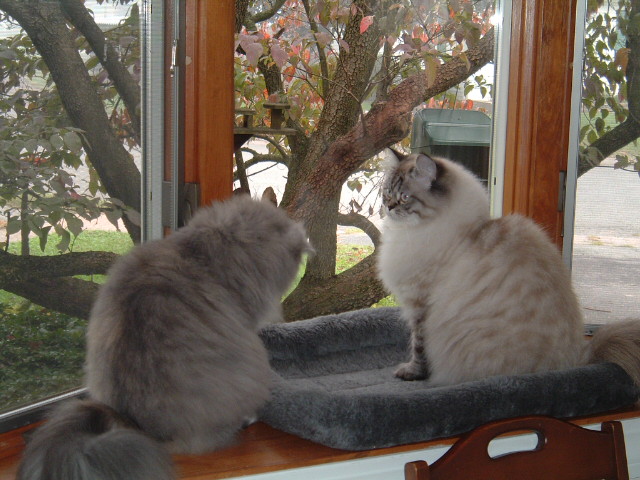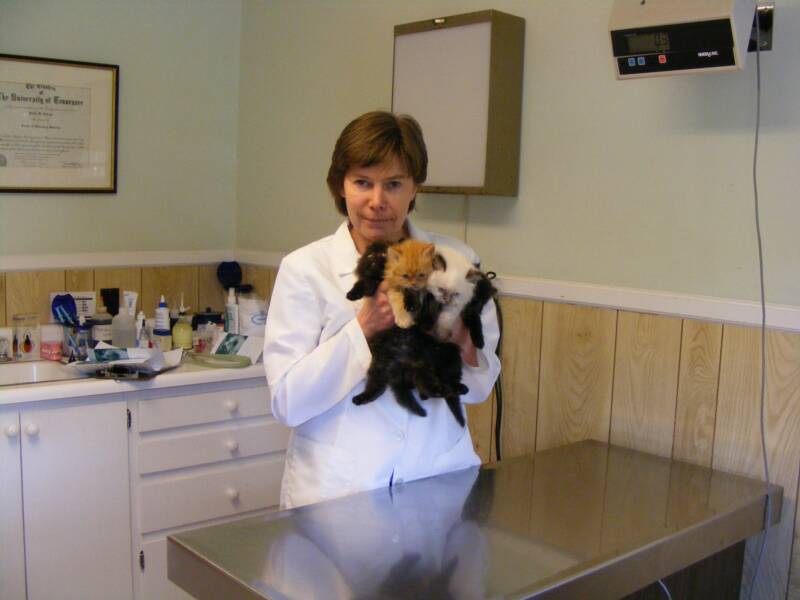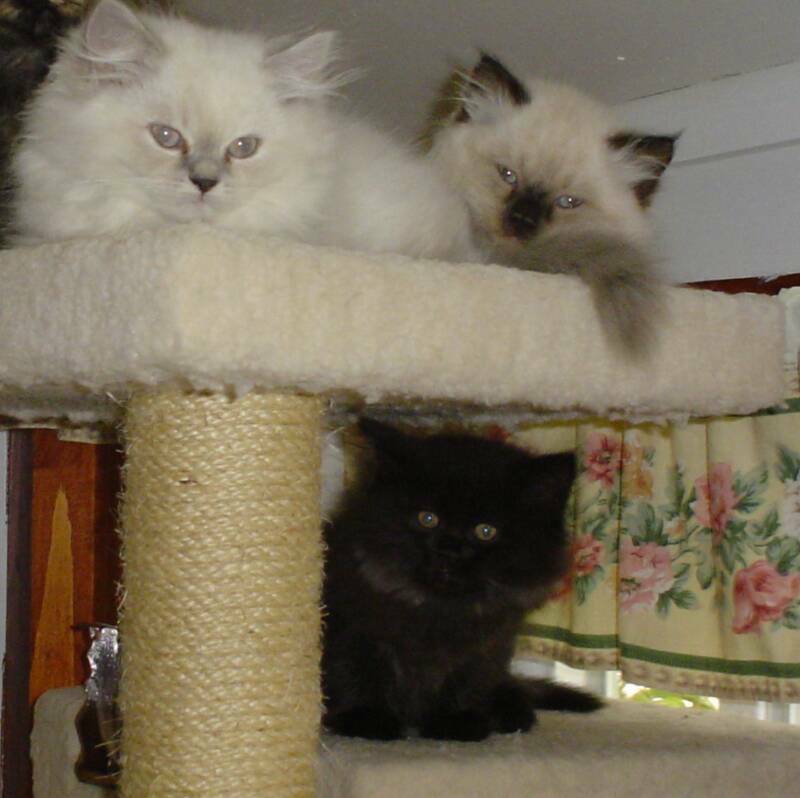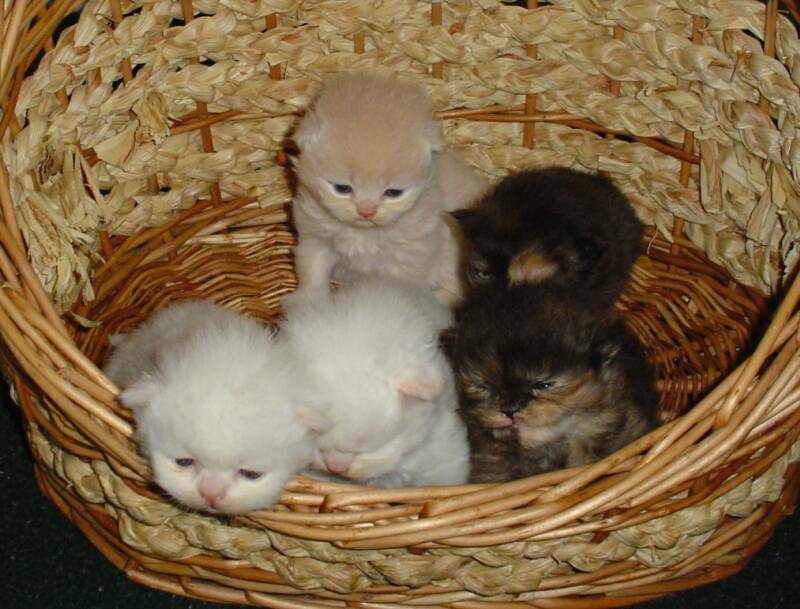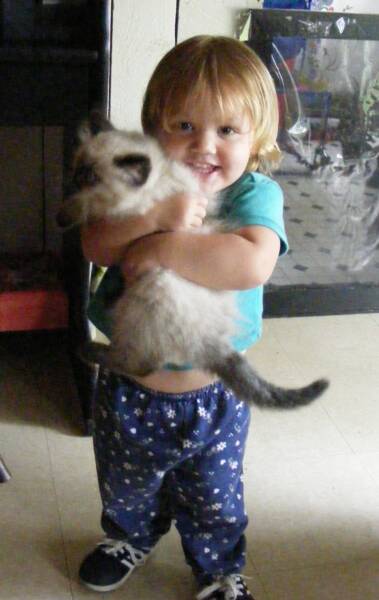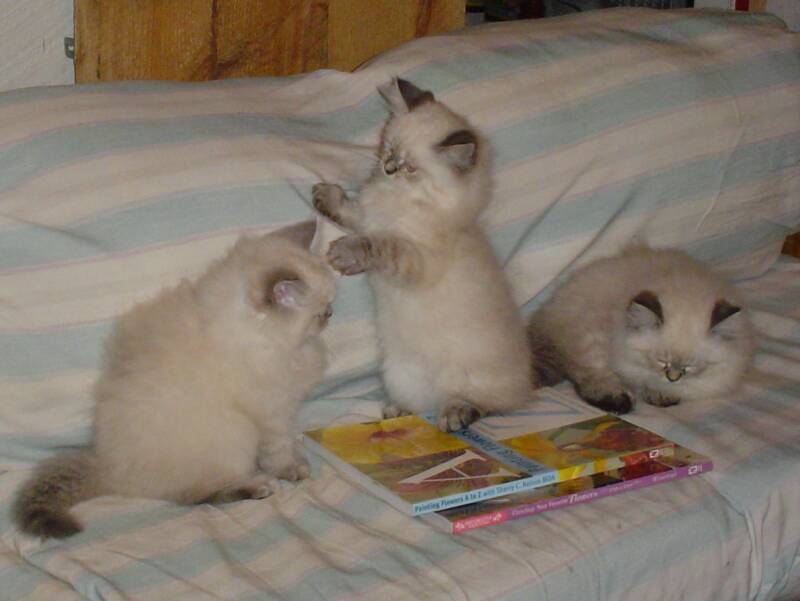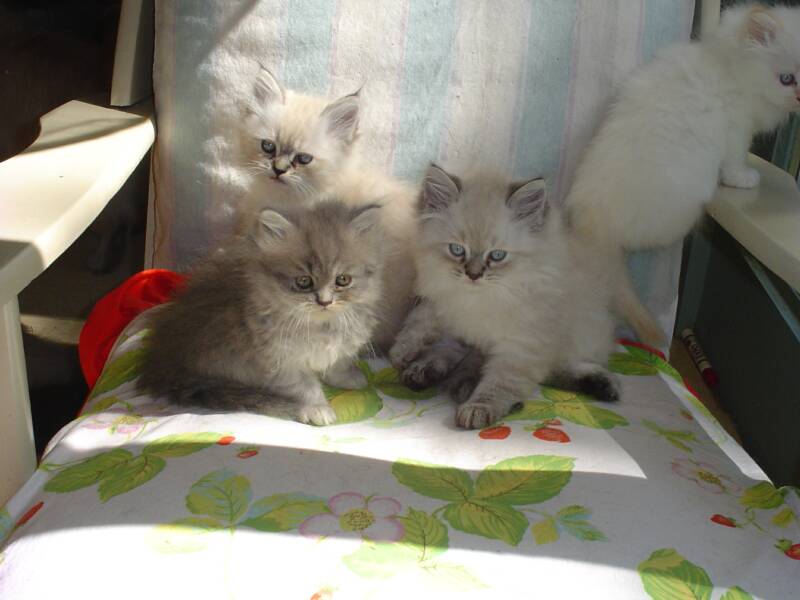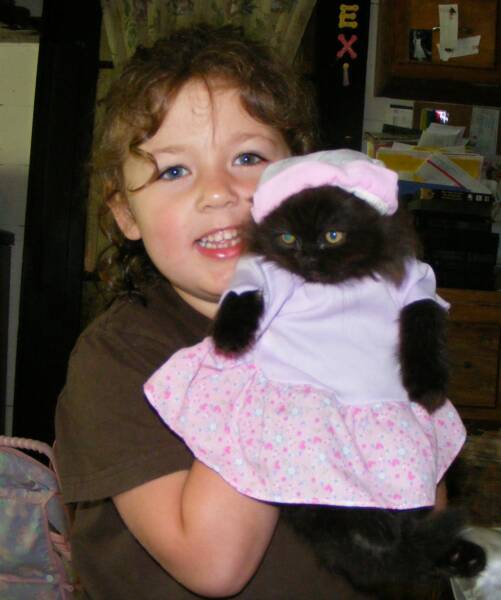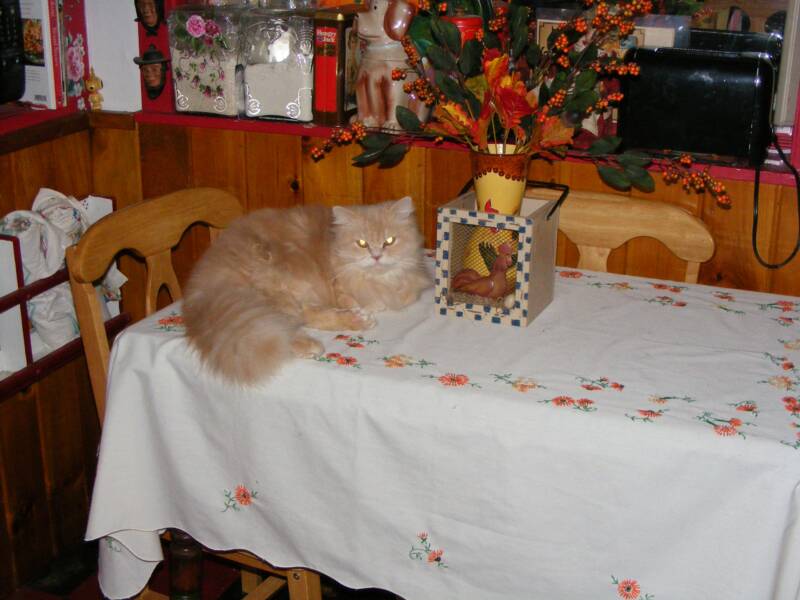 | ||||||
Bringing Your Kitten Home
You are now the proud adoptive parent of a brand new ball of fluff and you can’t wait to welcome your new kitten as a member of the family.
Just as bringing a new baby home involves a lot of preparation, so does the welcoming of a new kitten.
Your young kitten will be making a transition from our nursery where he or she is comfortable, to a new and even a little scary (but loving) environment. There are many steps that you can take to make this transition as smooth as possible for your kitten.
Pre-Kitten Arrival Shopping List
Before bringing your kitten home, you’ll want to stock up on some necessities. Check with us at Doll Face Cattery to find out what kind of food we feed our kittens and adults. It is recommended that you continue to feed your kitten this brand for several weeks after adoption, before very gradually switching to a new food, if you choose. This will avoid any unnecessary tummy troubles or loose stools to bother your kitten as he or she adjusts.
Buying the same brand of kitty litter that we use at Doll Face Cattery is a good idea as well, as the sight and texture will be what your kitten is accustomed to, and this familiarity could possibly prevent a few accidents.
Here’s a list of some other recommended kitten gear that you may want to have on hand before the big day:
Cat Carrier
Please bring your cat carrier with you, Make sure to pad the bottom of the carrier for both comfort, and as a precaution towards accidents.
Dishes, Food and Water
Be sure to monitor the kitten closely to make sure that it is eating and drinking, though they might do neither for a few hours after you first bring them home. We recommend both food and water dishes be emptied and washed daily to prevent bacteria and germs from accumulating.
Litter Tray/Scoop
You’ll want to have a litter tray ready and waiting and introduce your new kitty to it immediately. I like the covered variety, as it prevents litter from scattering to the four corners of the room at the first scratch of a paw. If your kitten does have an accident, wipe it up with a paper towel and then place the paper towel in the litter tray. After a little repetition, this will show your kitten that the correct place to use the potty is in the litter box. Don’t punish your kitten, as this will only cause him or her to not go in front of you. Kittens are very sensitive to odors so scooping twice a day will encourage regular use of the litter pan.
Grooming Set
A brush, a comb, and nail clippers will come in handy. You won’t be using them during the first week, but after your kitten is all settled in, you’ll want to establish a grooming routine.
Cat Tree
A good, sturdy sisal rope or carpet-covered cat tree can be a huge asset to any cat lover’s home, as the scratching post will stand up much better to needle-sharp little claws than your nice sofa or curtains. Make sure to get one that is at least 2 and a half-feet tall with a heavy base that won’t tip if your kitten gets a little enthusiastic. I also use natural slabs of wood for shelving, it still has bark on it and the cats love to scratch it.
Make Sure Your Home is “Kitten proof”
Since your kitten is still technically a baby, you’ll want to make sure that your home is kitten-proofed before he or she gets there. Keep all dangerous cleaning chemicals, pesticides, or antifreeze up and out of the way, or behind child-locked cupboard doors. Child locks can be picked up cheaply at any grocery store and you would be surprised at how dexterous kittens can be when it comes to opening cupboard doors.
In addition, any plants that may be harmful to kittens, such as those listed below should be kept out of reach.
One way to know for sure that your home is kitten-proofed is to stoop to their level, so to speak.
Get down on the floor and check out your home from their point of view.
Your Kitten’s Safe Room
When you bring your kitten home, have his or her own special place (ideally a separate room) set up and ready for them.
First Vet Check
Once you get your kitten home, you should schedule a checkup with your veterinarian as soon as possible. Scheduling a well visit for within the first few days of having your kitten at home will give your vet an opportunity to meet your kitten and record the health information to date that you will receive upon your kitten's arrival. At this time, you will also be able to schedule your kitten’s spay or neuter appointment and administer or schedule the last of your kitten's series of vaccinations. Any other questions about the care of your new kitten can also be answered at this time.
Introducing Your Kitten to Other Pets, Take your time!
If introducing your kitten to the rest of the family includes him or her making the acquaintance of your dog Fred and two elderly cats named Togo and Yoni, proceed with caution. Your other pets have staked a claim on your home and need to be reassured that the newcomer isn’t there to oust them. This process can take a few days to a week to be successful, be patient.
By quarantining your new kitten, your other pets will already have been aware that he or she is there, and had an opportunity to get used to their scent. When the first meeting takes place, keep it short. Let them all get the chance to see what that odd scent in the guest bedroom was, but don’t let your kitten become too frightened or your other pets too aggressive.
From then on, allow the pets to be in the same room together, with supervision, until they’ve all become used to each other. They will work out their issues, given time. This could take a week or more, but exercise patience and be sure to lavish attention and reassurance on your established pets, to stop any jealousy in its tracks.
By following these outlined steps, you will be able to welcome your kitten into your home with a minimum of fuss and stress on you, your new pet, and your established pets. Before long, your kitten will be settled in nicely, and so much a part of your family, it will seem like they’ve been their forever.
Newsletter from the Heart
But I just want to have one litter so the kids can see the kittens being born!
This is not a good reason to breed.
This newsletter from the heart is on breeding.
 | ||||||
 | ||||||
 | ||||||
 | ||||||
=
 | ||||||
 | ||||||
So You Want to Raise Kittens?
Many people begin as I did - with a pet cat. "We'll raise just one litter and then spay her." Famous last words spoken by many of us! The experience with that first litter often determines whether or not you will continue as a cat breeder or spay your cat and forget about breeding. If you are fortunate enough to have a friend. perhaps the person from whom you purchased your female, who will literally "hold your hand" and tell you what to do and what to expect, step-by-step, you are more apt to have a satisfying experience.
However, reality is their aren’t many breeders that want to share their knowledge or take the time to hold your hand. If you haven’t’ done your home work before breeding then you are on your own.
Most cats deliver their young in a no-nonsense manner. Some females or "queens" are calmer, some more high strung (especially with their first litter) and frequently the difference depends upon the breed of cat involved.
MAKING PLANS
Before I start I want to say that the only safe way to breed is to have your own queen and stud that you know the health history of the other cat.
Personally I would NOT BREED OUT! It just isn't worth the heart ache.
Now if you do have to breed out the first time be careful who you choose. Just because they are your friend doesn’t mean that their cats are taken care of the way you would take care of your own cats.
Now with that said hear is some great information to think about .
There are a number of things you should do once the decision is made to breed your female. If this is your first litter you are probably taking your girl out for stud service.
Once you have made your choice of studs, and the owner of that stud is willing to accept your female, a visit to your veterinarian is in order. If the owner of the male is conscientious, she will ask for a recent health certificate and FeLV test. If she doesn't require these - look elsewhere for a stud! The stud owner should also be willing to show you the results of a recent FeLV test for her male too. You should be just as concerned about the health of the male as the stud owner is about your female. In addition to these tests you should have your female checked for parasites and make sure she has been vaccinated within a couple of months of the breeding but not closer than three weeks before breeding.
It is very important to have a clear understanding of what you are paying for before you take your female to the male.
The stud owner should watch the cats breed at least once before leaving them together any length of time. Some breeders just toss the cats together and never know if they mate. Do you pay for stud service if no breeding is witnessed? If the female goes out of season and does not get bred, do you pay a stud fee or \ board?
If she is bred but does not conceive, do you get a return breeding?
If so, how many?
If you get one or more return stud services, do you pay board for the time she is there for return stud service? If your female becomes ill while out for breeding, who pays for veterinary care?
Will the owner of the stud hold you responsible if your female injures the stud?
And conversely, is the owner of the stud liable if the stud injures your female.
What constitutes a litter? If the kittens are stillborn, do you get another stud service?
Some breeders feel that if the stud has done what you paid for (impregnated the cat), that is the end of their responsibility; others feel you should get one, and sometimes two, live kittens.
Now that your girl is home, happy and hopefully pregnant, you can plan for the litter.
You or the stud owner may have confirmed pregnancy by examining the nipples which become enlarged and turn quite pink about three weeks after mating or she or her veterinarian may have been able to tell by palpating the abdomen. Some of the signs of pregnancy in animals are the same as humans - a tendency to sleep more and an increased appetite.
Also not to discourage you but your female will vomit at some where between 14-28 days. Just like a human they can get a touch of morning sickness. It wont last long, just a day or two.
WHERE TO DELIVER?
Think ahead to where you want your mother-to-be to have her kittens. The middle of the down comforter on your bed is NOT a good place. Nor do I like a closet floor because even in the best of locations it can be drafty. While my new moms are only in a crate at night, I am a firm believer in crates for certain situations. Kittening is one of the times I insist on crating. It eliminates all sorts of problems you can do without!
Many a breeder has gotten up in the morning to find dead newborns scattered all over the house while other mothers insist that every day is moving day until the babies have puncture holes in their necks.
About two weeks before delivery, put her in the crate and leave her there all night. I let her out during the day and watch her.
Delivery dates can be tricky too. I begin a kitten watch 63-65 days from the FIRST mating, NOT the last. I've had cats deliver anywhere from 65 to 69 days from that first breeding. Needless to say, she may not have conceived from that first mating or even the second - you'll never know; but it's much more expedient to keep a KITTEN WATCH from the 60th day on.
IS TODAY THE DAY?
Some cats give obvious hints when they are going to deliver, others give none. Most cats will skip the last meal before delivering; I have a couple of girls who will snack between kittens. Anything to make it more confusing..
I have no problem with knowing when the are going to deliver, they actually come get me.
For a couple of weeks before delivery, your girl will be looking for places to deliver. She will poke into dark corners, make a mess of your linen closet if you are careless enough to leave the door unlatched or take over your overflowing laundry basket.
Make sure you have an emergency plan listed on the wall next to the phone, I list two veterinarians just incase anything goes wrong.
SUPPLIES NEEDED FOR DELIVERY
(Many) old, soft face cloths
Heating pad
Small carrier which opens from the top or a container of some sort to put the pad in
Benidine
Small hemostat
Extra towels for bedding
Record book and pen
Permanent markers
Small scale which measures weight in small increments .
Aspirator
FIRST STAGE OF LABOR
In the first stage of labor, perhaps all you will notice after a general uneasiness in the cat is a slight mucous discharge or a more or less constant washing of her genital area. About a week earlier you will have clipped her "bottom" (if you have a long-haired cat). It is also a good idea to clip the hair around the nipples and massage them with Vaseline or cocoa butter if they seem crusty.
AND NOW.....
The second stage of labor begins with straining. Sometimes the queen will go into her litter pan and squat but do nothing. Sometimes they will even deliver their kittens in the litter pan - a very messy ordeal - so when the second stage begins I remove the litter and replace it with paper toweling.
If she delivers there - no problem - the kits won't be covered with litter. If she urinates in the pan, it is easily cleaned. You can see and feel the muscles of the abdomen contract as the straining becomes more pronounced.
To facilitate delivery, the vaginal opening will have enlarged and the vagina will be well lubricated. Though a cat will rest between contractions, the contractions will come closer and closer together as the kitten leaves one of the horns of the uterus and nears delivery. Some books will tell you that most kittens come "head first" - it would be nice if it were true. 50% head first delivery is about the best you can hope for. Hopefully, your girl will deliver her first kitten head first; rear first is a more difficult delivery, especially for the first kitten in the first litter.
Once the kitten is out you will probably find it is still pretty closely connected to the mother by the cord to the placenta (or "afterbirth") which she should expel fairly quickly. She probably will begin to lick the kitten right away but may be more concerned with washing herself, especially if it is her first litter. Either way, break the sac over the face of the kitten and begin to rub it lightly with a small cloth such as a face cloth.
If it is wiggling and making noise you have time for her to expel the afterbirth. If the kitten seems too quiet and lethargic, fasten the hemostat on the cord and holding the cord on the side closest to the mother, try to ease it out by pulling gently. This may stimulate a contraction. If it doesn't, it is probably safest to break the cord so you can take the kitten out of the nest to work on it.
Rub firmly with the washcloth and use the aspirator in the mouth to remove fluid. Hold the kitten between the palms of your two hands, head down, and swing briskly back and forth, pendulum fashion.
I find bending over and swinging the kitten between my legs is most convenient. Stop and aspirate again and continue rubbing; continue the swinging and aspirating as long as you think there is liquid in nose, mouth or lungs.
Continue to massage the kitten and "shake down". (Discuss this with your veterinarian ahead of time). If there is fluid coming from nose and/or mouth, use an aspirator to suction it - again with massage and shake down which helps to inflate the lungs and remove fluid.
KEPING RECORDS
Now is the time for you to apply benidine to the navel cord to prevent infection. After this you are ready for your record keeping.
If your kittens are all going to be "look-alikes", you will want to mark them. I
Found that clipping a little fur from the left leg, right leg , etc and documenting the color helps better than a marker that mom will lick off, weigh it and put it in the "incubator" on a well-covered, warm heating pad.
I have a computer program that I record everything.
THIS IS A SAMPLE OF RECORD KEEPING!
Stud Prince
queen Pricess
born: 6/5/2008 delivered: 65 days
*******************************************************************************
4:00 a.m. sealpoint (breech - difficult delivery) 4 oz
4:30 a.m. sealpoint female (headfirst) 3 ½ .oz
6:00 a.m. flame point male (headfirst) 4 oz
7:00 a.m. cream point female (headfirst) 3 ½ oz
The you will want to have a line for each kitten giving time of birth, color, sex, weight and a brief description of delivery. You will be surprised how valuable this will be in future breeding of this female.
If you weigh them daily at about the same time, you will know if they are gaining regularly. Don't count on your sense of touch to tell you this. You cannot tell a loss of 1/4 to 1/2 ounce and this can be serious with a very young kitten.
Watch the mother carefully to see if she delivers the afterbirth and check off somewhere on the record for each kitten, the delivery of the afterbirth. It is VERY important to count a placenta for each kitten.
IF YOU NOTICE A PROBLEM, CALL FOR HELP IMMEDIATELY
While most deliveries are problem-free, if a cat is in HARD labor for an hour and has not delivered a kitten, you should be concerned. Do NOT let anyone talk you into letting a cat continue in hard labor for more than two hours. (I tend to panic and phone the vet after one hour). It may be a simple problem where your vet can manually turn a kitten into a better delivery position. However, it could mean the kitten is just too large to deliver or it could even mean a torn uterus. In either case, a cat could labor forever and not deliver. The latter can, in most cases, be repaired for future eventless deliveries. Sometimes a cat needs a C-section but sometimes she just needs more expert help than you can give. Occasionally, labor stops and the veterinarian will give Oxytocin to start contractions again.
AT LAST!
Most queens, when they finish delivering, make it pretty obvious by their relaxed attitude. The bedding gets wet and messy with each delivery so you will have changed it a time or two and now it's time to change the bed again and return the kittens to their mother - one by one. The cage I use for delivery (24" deep, 24" high and 48" long) will be home for the family for about 4 weeks. It opens from the front and has a removable top.
RESPONSIBILITY
Now that your kittens are vaccinated you will be thinking about new homes for them. When I began breeding Himalayan and Persians, I sought out advice from other breeder friends, they gave me some advice which I have never forgotten. "You are responsible for every kitten you have caused to be born.
Now that you have read this information it will be easier for you to submit how you will present a breeding program of your own to: Doll Face Cattery.
The reason I ask for a written breeding plan is to help you become successful in your future cattery.
Remember your future babies will always link back to Doll Face Cattery.
I hope my information and experience of over 20 years will help you in the future.
Wishing you the very best in your new adventures. Pat and the critters
Bringing Your Kitten Home
You are now the proud adoptive parent of a brand new ball of fluff and you can’t wait to welcome your new kitten as a member of the family.
Just as bringing a new baby home involves a lot of preparation, so does the welcoming of a new kitten.
Your young kitten will be making a transition from our nursery where he or she is comfortable, to a new and even a little scary (but loving) environment. There are many steps that you can take to make this transition as smooth as possible for your kitten.
Pre-Kitten Arrival Shopping List
Before bringing your kitten home, you’ll want to stock up on some necessities. Check with us at Doll Face Cattery to find out what kind of food we feed our kittens and adults. It is recommended that you continue to feed your kitten this brand for several weeks after adoption, before very gradually switching to a new food, if you choose. This will avoid any unnecessary tummy troubles or loose stools to bother your kitten as he or she adjusts.
Buying the same brand of kitty litter that we use at Doll Face Cattery is a good idea as well, as the sight and texture will be what your kitten is accustomed to, and this familiarity could possibly prevent a few accidents.
Here’s a list of some other recommended kitten gear that you may want to have on hand before the big day:
Cat Carrier
Please bring your cat carrier with you, Make sure to pad the bottom of the carrier for both comfort, and as a precaution towards accidents.
Dishes, Food and Water
Be sure to monitor the kitten closely to make sure that it is eating and drinking, though they might do neither for a few hours after you first bring them home. We recommend both food and water dishes be emptied and washed daily to prevent bacteria and germs from accumulating.
Litter Tray/Scoop
You’ll want to have a litter tray ready and waiting and introduce your new kitty to it immediately. I like the covered variety, as it prevents litter from scattering to the four corners of the room at the first scratch of a paw. If your kitten does have an accident, wipe it up with a paper towel and then place the paper towel in the litter tray. After a little repetition, this will show your kitten that the correct place to use the potty is in the litter box. Don’t punish your kitten, as this will only cause him or her to not go in front of you. Kittens are very sensitive to odors so scooping twice a day will encourage regular use of the litter pan.
Grooming Set
A brush, a comb, and nail clippers will come in handy. You won’t be using them during the first week, but after your kitten is all settled in, you’ll want to establish a grooming routine.
Cat Tree
A good, sturdy sisal rope or carpet-covered cat tree can be a huge asset to any cat lover’s home, as the scratching post will stand up much better to needle-sharp little claws than your nice sofa or curtains. Make sure to get one that is at least 2 and a half-feet tall with a heavy base that won’t tip if your kitten gets a little enthusiastic. I also use natural slabs of wood for shelving, it still has bark on it and the cats love to scratch it.
Make Sure Your Home is “Kitten proof”
Since your kitten is still technically a baby, you’ll want to make sure that your home is kitten-proofed before he or she gets there. Keep all dangerous cleaning chemicals, pesticides, or antifreeze up and out of the way, or behind child-locked cupboard doors. Child locks can be picked up cheaply at any grocery store and you would be surprised at how dexterous kittens can be when it comes to opening cupboard doors.
In addition, any plants that may be harmful to kittens, such as those listed below should be kept out of reach.
One way to know for sure that your home is kitten-proofed is to stoop to their level, so to speak.
Get down on the floor and check out your home from their point of view.
Your Kitten’s Safe Room
When you bring your kitten home, have his or her own special place (ideally a separate room) set up and ready for them.
First Vet Check
Once you get your kitten home, you should schedule a checkup with your veterinarian as soon as possible. Scheduling a well visit for within the first few days of having your kitten at home will give your vet an opportunity to meet your kitten and record the health information to date that you will receive upon your kitten's arrival. At this time, you will also be able to schedule your kitten’s spay or neuter appointment and administer or schedule the last of your kitten's series of vaccinations. Any other questions about the care of your new kitten can also be answered at this time.
Introducing Your Kitten to Other Pets, Take your time!
If introducing your kitten to the rest of the family includes him or her making the acquaintance of your dog Fred and two elderly cats named Togo and Yoni, proceed with caution. Your other pets have staked a claim on your home and need to be reassured that the newcomer isn’t there to oust them. This process can take a few days to a week to be successful, be patient.
By quarantining your new kitten, your other pets will already have been aware that he or she is there, and had an opportunity to get used to their scent. When the first meeting takes place, keep it short. Let them all get the chance to see what that odd scent in the guest bedroom was, but don’t let your kitten become too frightened or your other pets too aggressive.
From then on, allow the pets to be in the same room together, with supervision, until they’ve all become used to each other. They will work out their issues, given time. This could take a week or more, but exercise patience and be sure to lavish attention and reassurance on your established pets, to stop any jealousy in its tracks.
By following these outlined steps, you will be able to welcome your kitten into your home with a minimum of fuss and stress on you, your new pet, and your established pets. Before long, your kitten will be settled in nicely, and so much a part of your family, it will seem like they’ve been their forever.
HIMALAYAN COLOR DESCRIPTION
This month I thought I would address the Himalayn color patterns and the variations.
This is a CFA chart and has very helpful to me in the past when explaining the colors to an adoptive parent and how I know the color of the kitten when it is still so white.
Hint: I check the color of the feet, you will read about this in each color group and every kitten pattern is a little different.
HIMALAYAN PATTERN
The points refer to the ears, face mask, legs, feet, and tail color. The ideal face mask extends from above the eyes and stretches beyond the eyes from side to side and down through the chin. Body - clear color is preferred with subtle shading allowed. Allowance for darker color in older cats as long as there is contrast between the body color and point color.
CHOCOLATE POINT
The body should be ivory and the points milk chocolate. The nose leather and paw pads cinnamon pink and the eye color a deep vivid blue.
SEAL POINT
The body should be even pale fawn to cream with gradual shading into lighter color on the stomach and chest. The points, nose leather and paw pads deep seal brown and eye color deep vivid blue.
LILAC POINT
The body should be glacial white and the points frosty gray with pinkish tone. The nose leather and paw pads a lavender pink color and eyes a deep vivid blue.
BLUE POINT
The body should be bluish white and cold in tone. The points blue with nose leather and paw pads slate blue. The eye color deep vivid blue.
FLAME POINT
The body should be creamy white and the points deep orange flame to red. Nose leather and paw pads flesh to coral pink and the eyes a deep vivid blue.
CREAM POINT
The body should be creamy white and the points buff cream. The nose leather and paw pads flesh to coral pink and eyes deep vivid blue.
SEAL TORTIE POINT
The body color should be creamy white or pale fawn. The points seal brown with unbrindled patches of red and/or cream. The nose leather and paw pads seal brown and/or coral pink. The eyes deep vivid blue.
BLUE CREAM POINT
The body should be creamy or bluish white and the points blue with patches of cream. The nose leather and paw pads slate blue and/or pink. The eyes deep vivid blue.
CHOCOLATE TORTIE POINT
The body should be ivory and the points chocolate with unbrindled patches of red and/or cream. The nose leather and paw pads cinnamon pink and/or coral pink. The eyes deep vivid blue.
LILAC-CREAM POINT
The body should be glacial white and the points lilac with patches of cream. The nose leather and paw pads lavender pink and/or pink. The eyes deep vivid blue.
HIMALAYAN LYNX PATTERN
The mask must be clearly lined with dark vertical stripes as well as form the classic "M" on the forehead and horizontal on the cheeks. The mask includes light rings around the eyes and dark spots on light whisker pads. The inner ear should be light with ticking on the outer ear. The legs should be evenly barred with bracelets and the tail barred with a lighter underside. There should be no mottling or striping on body.
